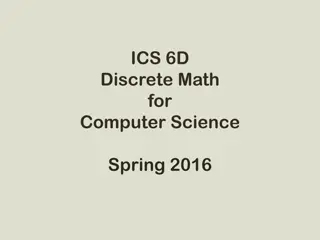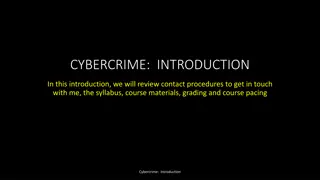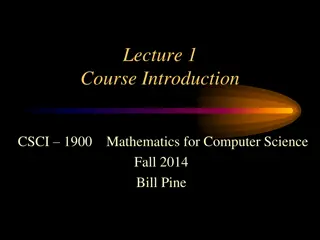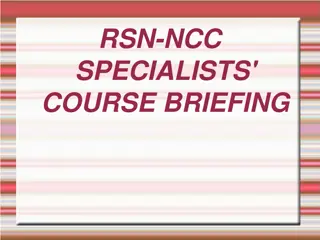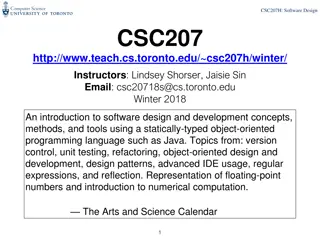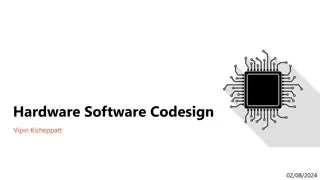
Exploring Wireless Networks and Mobile Communication in IT Department
Dive into the world of Wireless Networks and Mobile Communication Systems with the IT Department's course on Wireless Networks and Mobile Communication Systems. Uncover the intricacies of different types of wireless networks, network architectures, electromagnetic waves, antenna characteristics, impairments in wireless networks, and satellite communications. Join this course to enhance your understanding of modern communication technologies and their applications.
Download Presentation

Please find below an Image/Link to download the presentation.
The content on the website is provided AS IS for your information and personal use only. It may not be sold, licensed, or shared on other websites without obtaining consent from the author. If you encounter any issues during the download, it is possible that the publisher has removed the file from their server.
You are allowed to download the files provided on this website for personal or commercial use, subject to the condition that they are used lawfully. All files are the property of their respective owners.
The content on the website is provided AS IS for your information and personal use only. It may not be sold, licensed, or shared on other websites without obtaining consent from the author.
E N D
Presentation Transcript
Faculty of Computer and Information Sciences Information Technology Department
Course Name Wireless Networks and Mobile Communication Systems Course Code IT 331T Lecture 0: Course Contents
Instructor information Name: Dina Samir Moussa Hassan Email: DSHassan@pnu.edu.sa Office #: 0.701.27 Office hours: Mon:1:00 4:00pm Tue: 10:00am- 12:00pm & 1:00 3:00pm
Textbooks Wireless Communication and Networks" , by William Stalling , Prentice- Hall, The Latest Edition. Wireless Communications: Principle and Practice", by T. S. Rappaport, Prentice-Hall, The Latest Edition. Data Communications and Networking By Behrouz. A. Forouzan, McGraw Hill, Fifth Edition 19-Mar-25 Information Technology Department
Instructions Information Technology Department
Attendance 25% 15 10% 6 20% 12 ) - 1 ( 3 : 25 % Information Technology Department
Course grading Percentage from overall Grade Assessment Method Grade Assessment Week Comments 21/9/2021 (5:00-5:30pm) 13/10/2021 (12:00-1:00pm) 3/11/2021 (5:00-5:30pm) Quiz 1 (Online) Week 4 10 % 10 Midterm Exam 1 Week 7 20 20% Quiz 2 (Online) Week 10 10 10% Project Report Project discussion (Tutorial, Lab)/Assignments Final Exam Week 11 Week 12 5 5 5% 5% 10 10% Weeks (5, 9) After week 15 40 40%
Coursedescription: Assessment methods Week Topic Activity Intended Learning Outcome Identify different types of the wireless Networks and its component. Understand the network architecture of networks Quiz, Exam 1 Introduction Lecture 1.Study electromagnetic waves and electromagnetic spectrum. 2.Define antenna characteristics. 3.Understand the different types of impairments present in wireless networks and analyze their impact on communication system performance. "Antennas: definition, radiation patterns, antennas types. Antenna characteristics: gain, effective area, attenuation, free space loss, noise, Eb/N0, fading. Lecture, problem solving, assignment. Exam, Assignment, Homework 2 & 3 "Satellite Communications: parameters, satellite versus terrestrial communications, orbits, LEO,MEO, GEO, frequency bands, capacity allocation. Lecture, problem solving, class assignment, Study satellite services, satellite network configuration and radio spectrum allocation Exam, Assignment, Homework 4 & 5
Lecture participation, discussion, problem solving. Study the evolution of wireless standards and systems , elements of a cellular network, cellular network architecture and the design its design objectives. Learn the protocol architecture of the WIFI network, and the different protocols used at each layer. Cellular Wireless Networks: Organization, frequency reuse, operations, power control, TDMA, GSM Exam, Assignment, Homework 6 & 7 IEEE802.11 Standard: architecture, Mac format, LLC, components, services, Mac protocols, physical layer, dynamic spread spectrum, frequency hopping. Lecture problem solving. 8 & 9 Exam Learn the protocol architecture of the Bluetooth network, and the different protocols used at each layer. Bluetooth: applications, piconet, radio layer, baseband layer, L2Cap layer. Lecture, problem solving 10&11 Exam IEEE 802.15:Bluetooth versus Zigbee, components of Zigbee, Zigbee network topology, device architecture, physical layer functionalities, network setup, beacon and non-beacon operations, mac layer. Lecture, problem solving Learn the protocol architecture of the ZIGBEE network, and the different protocols used at each layer. 12 Exam Lecture participation, discussion, problem solving Exam, Mini project, Report, Presentation Study the evolution of the cellular networks from 1G analog FDM to 4G LTE OFDM Mobile Networks Fundamentals: Generations, Topologies, and Components 13&14 Wireless network devices: wireless network interface cards, access point, bridge, gateway " Lecture, discussion Study networking devices and wireless network devices and components 15 Exam
Course Syllabus Introduction "Antennas: definition, radiation patterns, antennas types. Antenna characteristics: gain, effective area, attenuation, free space loss, noise, Eb/N0, fading. "Satellite Communications: parameters, satellite versus terrestrial communications, orbits, LEO, MEO, GEO, frequency bands, capacity allocation. Channelization, TDMA, FDMA, CDMA Spread spectrum Systems Cellular Wireless Networks: Organization, frequency reuse, operations, power control, TDMA, GSM IEEE802.11 Standard: architecture, Mac format, LLC, components, services, Mac protocols, physical layer, dynamic spread spectrum, frequency hopping. Bluetooth: applications, piconet, radio layer, baseband layer, L2Cap layer. IEEE 802.15: Bluetooth versus Zigbee, components of Zigbee, Zigbee network topology, device architecture, physical layer functionalities, network setup, beacon and non beacon operations, mac layer. "Wireless network devices: wireless network interface cards, access point, bridge, gateway Mobile Networks Fundamentals: Generations, Topologies, and Components.


